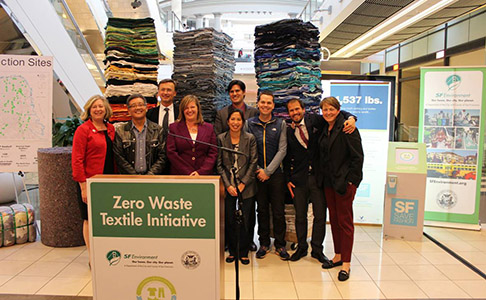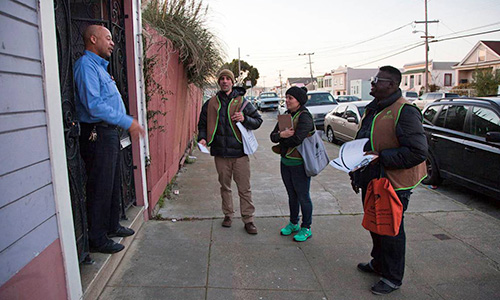Last month, the City of San Francisco announced it had set aside $860,000 from refuse fees to fund zero-waste efforts, and that the money was available for new projects that can help the City reach its goal of 100 percent waste diversion by 2020.

Unwanted clothing accounts for a sizable portion of the 400,000 tons of waste that San Francisco sends to landfills each year. The City launched the Zero Waste Textile Initiative in 2014, which put convenient donation bins in retail locations throughout the City to get these items out of the waste stream and into the hands of less fortunate San Franciscans. Courtesy of SF Environment.
By Bill Picture
Published: April, 2015
Last month, the City of San Francisco announced it had set aside $860,000 from refuse fees to fund zero-waste efforts, and that the money was available for new projects that can help the City reach its goal of 100 percent waste diversion by 2020.
The amount of waste San Francisco sends to landfills has decreased by 50 percent since 2000, and city officials believe it’s nonprofits that hold the key to finding a way to divert the remaining 400,000 tons that end up on Bay Area trash heaps each year.
“San Francisco nonprofits are natural problem solvers,” said San Francisco Commission on the Environment President Joshua Arce in a written statement. “These organizations know that good solutions to our environmental issues, like eliminating waste, also build community and create opportunity.”
San Francisco’s 50 percent waste reduction is especially impressive given that its population grows denser and denser each year—more people typically means more landfill-bound waste. Alexa Kelty, zero waste specialist at the San Francisco Department of the Environment (SF Environment), said that the credit for San Francisco cleaning up its act goes to an aggressive rollout of a comprehensive series of programs aimed specifically at achieving zero waste.
“It took a while, but we’ve finally completed the rollout of all of our programs,” she said. “Every apartment building with more than six units now has a composting program, and we’re nearly there with commercial businesses.”
When SF Environment began reaching out to residents and businesses about adding a green bin to their waste stations (and using it), about 400 tons of organic waste was being composted each day. At present, that number has increased to 600 tons each day, and Kelty chalks that success up to SF Environment’s ongoing outreach efforts.
“It took literally going out into the neighborhoods, knocking on people’s doors, and having a conversation with them,” she said. “That’s way more effective than fining people, which we have the authority to do under the Mandatory Composting and Recycling Ordinance passed in 2009. Some counties came right out the gate fining; and I feel like education has proven to be a lot more effective.”
But what about the 400,000 tons?
SF Environment says that more than half of the waste still bound for landfills each year is either recyclable or compostable. Given our love of all things tech and our obsession with having the latest and greatest gadget, one might expect to see a lot of electronic waste in that trashy mix.
“Surprisingly not,” Kelty said. “A lot of what ends up in landfills is actually food. And much of that food is edible.”
While food scraps and expired perishables belong in the compost bin, perfectly good food shouldn’t enter the waste stream at all. This includes unsold prepared items and perishable items that are past their specified sell-by date but not yet expired.
There are nonprofits that collect these items from restaurants and markets and deliver them to hunger-fighting agencies, but a lot of food is still getting dumped. To help, SF Environment awarded money to the SF Food Bank as part of last year’s grant process to expand its Local Fresh Grocery Rescue Program and hire drivers to capture more of this food so that it gets to the dinner tables of hungry San Franciscans.
“There are also a lot of textiles in the waste stream,” Kelty added. She estimates that roughly 18,000 tons of clothing and accessories (shoes, belts, purses) end up in landfills each year. These items, whether damaged or simply out of style, can make welcome additions to the wardrobes of less fortunate San Franciscans.
To help keep these items out of dumps, San Francisco launched its Zero Waste Textile Initiative last year, which saw collection boxes scattered throughout the City to make donating unwanted clothing and accessories easier and more convenient.
“Pretty soon, all high-rise residential buildings will have their own collection box,” Kelty said. “And Recology is working on a pilot program to accept textile donations curbside.”
The path ahead to zero waste
“Now that all of our programs are up and running, we’re evolving into a very operations-focused organization,” Kelty said. “The feeling now is, ‘Let’s focus our efforts and energy on getting the programs working their best, and maximizing their use.’ And that means continuing and strengthening our outreach and education efforts.”
Because San Francisco’s demographics continue to change and people are coming and going constantly, Kelty doesn’t foresee a day when going door-to-door to educate San Franciscans about zero waste is no longer necessary.
“I don’t think we’ll ever be finished on that front,” she said. “There’s so much turnover. And the people that have been here a while, they get it. It’s the new people that we have to get our message to.”
SF Environment initially encountered challenges in engaging non-English speakers and members of other underserved communities. They’ve since found a way to tailor the zero-waste message for each community they’re trying to reach. “Yeah, we’ve gotten really good at reaching beyond those cultural and language barriers,” Kelty said.
The challenge SF Environment now faces is learning to speak the language of San Francisco’s newest demographic—the tech set. “They’re very busy, and their world moves very fast,” Kelty said. “It’s forced us to be innovative in the way that we communicate. We already had a social media presence, but we have to spend more time and energy outreaching through those mechanisms because that’s how this crowd communicates.”
In terms of the forthcoming grants, Kelty expects to see a lot of proposals from familiar faces hoping for a chunk of the money, but she’s excited to see what the new kids on the green block dream up.
The City offered grants in three target areas where it needs an extra push to meet its zero-waste goal. Interested parties were asked to submit proposals that engaged a specific neighborhood, increased participation in zero-waste programs among underserved communities and/or addressed the importance of sustainable and reduced consumption—that is, not buying items that will end up in landfills.
In addition to the SF Food Bank, past awardees have included: the Boys and Girls Club of San Francisco, who used the money to increase collection of recyclables and compostables at their 10 locations; and Clean City Coalition, who used the money to continue operating a wood furniture refurbishing and pallet repair program.
“A lot of the money will go to existing programs like these, to keep them going and hopefully help them expand,” Kelty said. “But this is the Bay Area, so there’s always a handful of really innovative new ideas—things that we’ve never even thought of.”

San Francisco has reduced landfill bound waste by 50 percent since 2000 despite its increasingly dense population. One way it has achieved this is by sending Department of the Environment representatives door-to-door to explain to residents and businesses how they can participate in zero-waste programs. Photo by Ben Boyer

